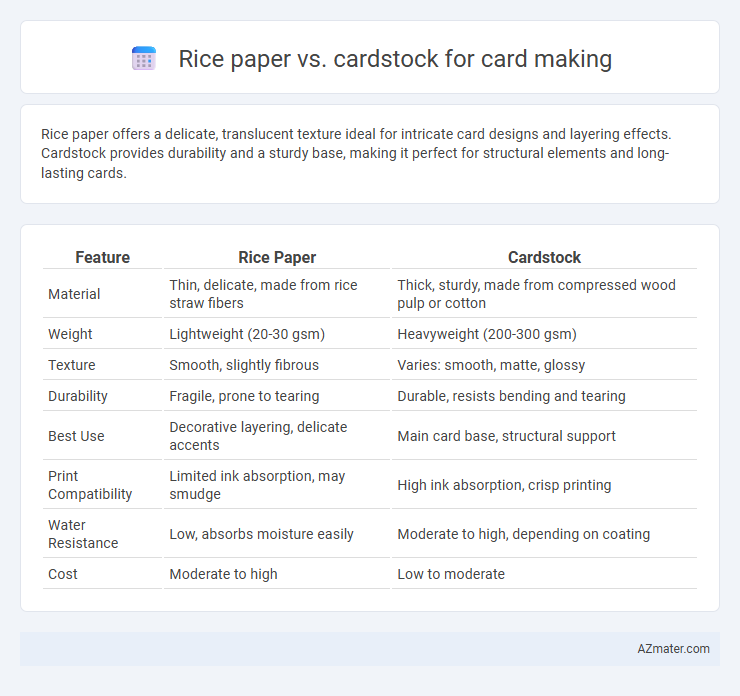Rice paper offers a delicate, translucent texture ideal for intricate card designs and layering effects. Cardstock provides durability and a sturdy base, making it perfect for structural elements and long-lasting cards.
Table of Comparison
| Feature | Rice Paper | Cardstock |
|---|---|---|
| Material | Thin, delicate, made from rice straw fibers | Thick, sturdy, made from compressed wood pulp or cotton |
| Weight | Lightweight (20-30 gsm) | Heavyweight (200-300 gsm) |
| Texture | Smooth, slightly fibrous | Varies: smooth, matte, glossy |
| Durability | Fragile, prone to tearing | Durable, resists bending and tearing |
| Best Use | Decorative layering, delicate accents | Main card base, structural support |
| Print Compatibility | Limited ink absorption, may smudge | High ink absorption, crisp printing |
| Water Resistance | Low, absorbs moisture easily | Moderate to high, depending on coating |
| Cost | Moderate to high | Low to moderate |
Introduction: Comparing Rice Paper and Cardstock for Card Making
Rice paper offers a delicate, translucent texture ideal for creating elegant, lightweight cards with a unique visual appeal. Cardstock provides a sturdy, durable base that supports various embellishments and maintains structural integrity for professional-quality cards. Choosing between rice paper and cardstock depends on the desired aesthetic and functionality of the finished card project.
Material Composition: Rice Paper vs Cardstock
Rice paper is made from natural fibers such as mulberry, hemp, or other plant sources, providing a thin, translucent texture ideal for delicate layering and intricate designs in card making. Cardstock consists of dense, cellulose-based fibers often derived from wood pulp, offering thicker, more durable support suitable for robust card bases and structural elements. The distinct material composition of rice paper lends itself to ethereal, lightweight aesthetics, whereas cardstock provides a solid foundation and rigidity essential for most card crafting projects.
Texture and Finish Differences
Rice paper offers a delicate, translucent texture with a slightly rough, fibrous finish ideal for layered, lightweight card designs. Cardstock provides a sturdy, opaque surface with a smooth or textured finish, enhancing durability and a premium feel for heavy-duty or embossed cards. The choice between rice paper and cardstock significantly impacts the tactile experience and visual depth of handmade cards.
Durability and Strength for Card Projects
Rice paper offers a delicate, translucent texture ideal for decorative elements in card making but lacks the durability and strength needed for structural components. Cardstock provides superior sturdiness and resilience, ensuring cards withstand handling and maintain their shape over time. For card projects demanding longevity and firm support, cardstock is the preferred material due to its thickness and durability.
Printability and Media Compatibility
Rice paper offers delicate texture and semi-transparency ideal for watercolor and ink prints but often struggles with heavy ink absorption and may cause smudging or bleeding in detailed designs. Cardstock provides superior printability due to its thicker, smoother surface, ensuring crisp, vibrant printing and excellent media compatibility with laser and inkjet printers. For card making, cardstock is generally preferred for sharp image reproduction and durability, while rice paper suits projects emphasizing artistic texture and layered effects.
Best Uses: When to Choose Rice Paper
Rice paper is ideal for delicate, intricate card designs requiring a lightweight, translucent texture that adds an elegant, ethereal quality. It works best for layered effects, overlays, and embellishments where subtlety and softness are desired, such as wedding invitations or artistic greeting cards. Choose rice paper when you want to emphasize fine detail and a unique, textured finish that cardstock cannot replicate.
Best Uses: When to Choose Cardstock
Cardstock is ideal for card making when durability and structure are priorities, such as for invitations, greeting cards, and layered designs that require weight and stability. Its thicker composition allows for clean folds and sturdy bases that hold embellishments securely, making it preferable for cards needing longevity and frequent handling. Choose cardstock over rice paper when crisp lines, solid colors, and resilience are essential for professional-grade craft projects.
Aesthetic Effects and Design Flexibility
Rice paper offers a delicate, translucent texture that enhances aesthetic effects with subtle depth and an organic, handmade feel ideal for layering and mixed media projects. Cardstock provides superior design flexibility due to its sturdiness and availability in various weights, colors, and finishes, supporting techniques like embossing, stamping, and die-cutting without warping. The choice between rice paper and cardstock impacts the visual impact and tactile quality of cards, balancing ethereal elegance with structural versatility.
Cost Comparison and Availability
Rice paper typically costs more than cardstock due to its delicate texture and specialized production process, often priced between $0.50 to $1.50 per sheet. Cardstock is widely available in various weights and finishes, with prices ranging from $0.10 to $0.50 per sheet, making it a more budget-friendly option for card making. While rice paper may be less common in local craft stores, cardstock enjoys broad availability both in physical stores and online retailers.
Conclusion: Choosing the Right Paper for Your Card Making Needs
Rice paper offers a delicate texture perfect for intricate designs and layered effects, while cardstock provides durability and a sturdy base ideal for folding and embellishments. Selecting between rice paper and cardstock depends on the desired finish, project complexity, and handling requirements. Opt for cardstock when strength and longevity are priorities, whereas rice paper suits lightweight, decorative elements in card making.

Infographic: Rice paper vs Cardstock for Card making
 azmater.com
azmater.com